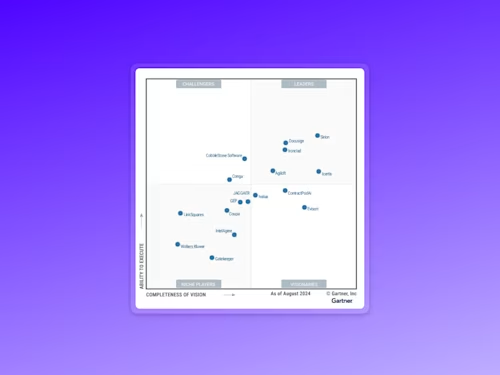
How Digital Leaders Manage Contracts Differently
Digital leaders outpace laggards in benefits of automation – like faster deal cycles and data sharing. 7 findings from The State of Systems of Agreement report.


Organizations are under pressure to digitally transform business processes to deliver these three things:
Better customer experiences
Improved productivity
Reduced costs
One area that is increasingly becoming a priority is contract lifecycle automation.
What is a contract lifecycle?
When people talk about contract lifecycle management, they are generally referring to the collection of technologies and processes used for preparing, signing, acting on and managing their agreements. Agreements can include sales and vendor contracts, offer letters, policy updates and many other types of written contracts used across nearly every business function.
To assess how organizations are managing the contract lifecycle, Docusign commissioned Forrester Consulting to survey 1,087 global decision makers.
A key finding was the clear delineation between organizations operating with more digitally mature contract processes (digital disruptors or digital leaders) versus those less evolved in their contract technology. Digital leaders outpace digital laggards in both practices and benefits experienced.
What digital leaders do differently in managing contracts
Here are seven top findings we discovered in this annual study.
1. Digital leaders outperform lower maturity digital laggards
Organizations that are further along in digitizing their contract lifecycle experience more benefits and outperform lower-maturity competitors. “Particularly, digital disruptors experience higher instances of silo breakdowns, faster deal cycles and easier information transfer—illustrating how a digital agreement process improves functionality and innovation across the board.”
2. Digital leaders were better able to meet the changing needs of the pandemic
The immediate shift to remote work as a result of COVID-19 required organizations to adapt quickly to maintain business continuity. With contract automation solutions already in place, digital disruptors can respond more quickly to unexpected changes. As a result, they were better prepared to pivot to managing the contract process remotely when the pandemic forced that shift.
3. Pandemic-driven technology purchases will remain in place
Many businesses and institutions implemented or expanded their use of technologies such as web conferencing and electronic signature in response to remote work requirements. Now organizations are embracing these digital tools for their overall impact on business performance and 96% say they will continue to use the newly implemented solutions even as the pandemic subsides. This is important because digital technologies can help prepare organizations for disruptive events such as supply chain interruptions, new market entrants and rapid growth.
4. Digital leaders utilize contract lifecycle management and contract analytics tools more fully than their lower maturity counterparts
Many organizations start with electronic signature technology to remove the bottleneck of requiring a physical signature. The next step is to consider contract lifecycle management (CLM) solutions that automate contract workflows and standardize processes to reduce risk.
The survey found 40% of digitally mature organizations are leveraging CLM software to connect and automate the contract lifecycle, compared to only 3% of lower maturity operations. Leaders are also much more likely to use contract analytics software that automates the analysis of agreements with AI technology to help uncover risks, obligations and opportunities before and after execution.
5. The more contracts an organization manages, the more they stand to benefit from automation
As the number of agreements increases, so too does the complexity of processing and scalability. Research shows that using digital technologies across the contract lifecycle helps organizations process higher volumes of contracts compared to those managing contracts manually.
“Digital disruptors are better able to manage higher volumes of contracts because their reliance on digitized, automated processes decreases costs, increases speed of completion and improves the agreement process experience. Technology solutions that provide automation and support across the entire process will be crucial for organizations of all maturity levels.”
6. Integration between systems across the contract lifecycle matter
Survey results highlight the impact of disconnected technology handoffs in the contract process. In document generation, for example, more than half of respondents experience inefficiency due to manually transferring customer or product information from existing systems to contracts. Manually adding information often leads to rework to correct errors that inevitably occur. Once a contract is signed, 56% of organizations report conducting duplicate work to re-enter data from signed agreements into systems of record.
Point solutions to automate document generation or e-signature work do offer incremental productivity improvements, but tools in each phase should be connected into a single, integrated contract lifecycle workflow to make sure end-to-end digital transformation is successful.
7. Manual processes cost organizations time, money and their sanity
One interviewee described how manual recruiting processes can be detrimental, especially during a pandemic: “Imagine having to gather 25 signatures for [a contract]. They'd have to hand it around to 25 people in the office. Not all of them are in the same place, certainly not now given the pandemic, and some aren't even in the same country. That paperwork physically gets posted around the world before it gets returned, and that prolongs the onboarding process dramatically.”
Turn your organization into a digital leader
To start or accelerate your organization’s efforts to automate your contract lifecycles, consider which contract workflows may be quick wins because they could be easily automated. Alternatively, there may be processes that are causing significant pain and offer a high value return based on the significance of the business impact.
Digital leaders shorten contract lifecycles with:
Templates to prepare often used contracts
Integration with existing systems that automatically populate contracts with data
Electronic signatures to gather signatures from virtually anywhere, anytime
Digital verification to identify signers
Systems of Record such as CRM, HCM and ERP systems that capture most or all of the information in agreements
Centralized storage that can be easily searched using automated tools and analytics
Contract analytics both before and after contract execution
Here’s helpful advice from two digital leaders:
“Preparation is key. Having a solid foundation and process where everybody is on the same page, understands who is responsible for what element of the process, how it’s going to work, and how it’s mapped out…there’s a lot of value in that. It makes rolling out more straightforward; having a rough idea of how it’s all going to work made it easier for us to upscale as quickly as we did.” ~ Legal industry customer
“There needs to be full support from the top down. [It helps] with consistency and understanding. Start early with cybersecurity, compliance, legal teams, and strive to get their support and approval altogether so there’s common knowledge.” ~ Financial services customer
Read the full research report: The State of Systems of Agreement
Related posts
Docusign IAM is the agreement platform your business needs



